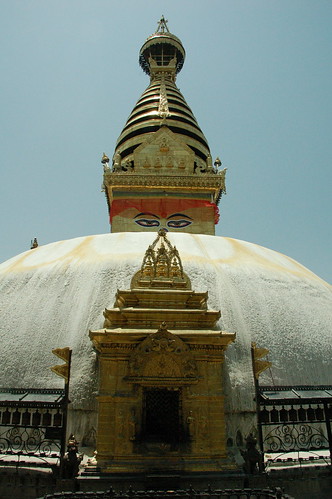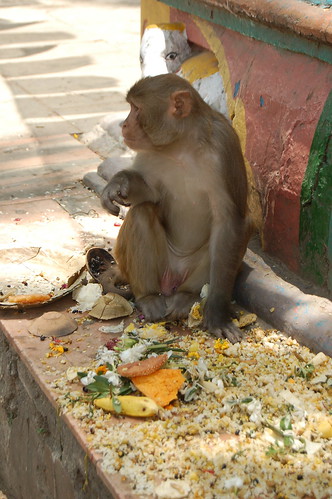I woke up in a muggy hotel room in Kathmandu, sweating from the heat. We would have slept with the windows open if it hadn't been for the monkeys. Yes, I said monkeys. On our way through the streets of Kathmandu the day before I had witnessed a rather large monkey climb a building, go through an open window and out again with a piece of cake clutched in its hand. I began to notice monkeys everywhere. They swung across power lines, and walked among people and grocery stalls, stealing food and taking various other things. The people seemed to take no notice of them. I swear there should be monkey police with the authority to arrest monkeys for shoplifting! So we slept with the windows tightly shut.
Although a bit jet-lagged, I was famished. We—being me, my sister, my parents, and my grandparents—sat down to a wonderful, “American” breakfast of eggs, bacon and toast, with tasty mango juice.
After breakfast, my grandparents informed us that they had planned to take us to Swayambhunath, otherwise known as the Monkey Temple. The Monkey Temple is a giant temple where monkeys thrive and are worshiped. I suddenly realized why the monkeys on the streets are never bothered; to the Nepalese, they are holy. I had decided I didn't like monkeys, so I voted against it. But my parents and grandparents agreed to go, and so I tagged along with them.
We jumped into a couple taxis and made our way through Kathmandu's hectic streets. The ride itself was interesting. First of all, there are no lanes marked, which means no organized traffic. There were also people crowding the streets, and cows wandered aimlessly among the people. Cars forced their way through the crowd, people moved out of the way at their own leisure. The rules for driving in Kathmandu? No hitting women, children, or cattle. That's it.
It was a hot day, so all the windows of our taxi were open. Now this helped with the heat, but it gave us another problem—the stench (which was a curious mix of garbage, curry, and sugary sweets). Waste lined the edges of the road—both human and animal—and garbage was also plentiful on the street and sidewalk. Buildings crowded the road on either side, houses built on top of each other as high as possible.
At last we reached the Monkey Temple. Tourists and locals alike swarmed over the temple grounds. And it was, indeed, a monkey temple. Monkeys were everywhere you looked—hanging from the trees, running along the temple walls and stairs, scampering over the statues and altars. They screeched loudly and strutted around, walking among the people, snatching things from both tourists and locals. And every single pair of those beady black eyes seemed to be trained on me.

Now, I'm exaggerating a little bit, but the monkeys were really creeping me out. But, we continued on up the stairs and to the top of the temple. Immediately the smell of incense hit me as it permeated throughout the temple. Both solid and temporary shops were set up, filled with brightly colored rugs, shining incense holders, the strong smelling incense itself, and many other things as well.
My parents bought me a singing bowl, which was intricately designed and smooth to the touch. As I ran the wooden mallet along the cold metal rim of the bowl, it produced a haunting hum—a sound that I still love to this day. They also bought me a Nepali game, which was a rendition of an old Egyptian chess game. The game was cool, but unfortunately, didn't come with any instructions. Luckily, the wizened stall vendor patiently sat with me and taught me how to play, using gestures and his stilted English to step me through the game.
After a couple of hours at the monkey temple, checking out the shops and reading about the history of the temple, I began to warm up to the monkeys. They were more funny than creepy now, and I got used to their incessant screeching. Their beady black eyes seemed to look at me curiously instead of glaring at me. By the time we left, I almost liked the furry creatures. Along the way of shopping and getting used to the monkeys, I learned some of the history of the temple. It apparently 'rose from the ground' in 640 CE, and is one of the oldest religious sites in Nepal. Its original name, Swayambhunath, means 'self-arisen', and the Nepali people believe that the temple rose from the ground fully built.
After a long day of exploring, we returned to the hotel. As we entered, the smell of the food hit me before I even laid eyes on it. After we were led into the dining room and were seated, giant dishes of steaming food were placed in front of us, the mouthwatering smell of spicy curry and crisp garlic naan flowing into my nose.
I'd had some good food before, but this food was amazing. Chicken, swirled within a spicy curry sauce, was served with a side of crisp, fried naan bread, all on top of a heap of steaming rice. There were also various other side dishes, including a tasty wonton soup and fried dumplings called momos. A hot, rather spicy tea called chai was also served, made with cream, sugar, ginger and cinnamon.
As we sadly scraped the last bits of goodness off our plates, we recounted our experience at the Monkey Temple. That night, as I lay in bed, my stomach full and content, I could hear the screeching of the monkeys a long way off. I slept peacefully, dreaming of the cute, furry creatures I had come to love.

Jackson Duckworth is a member of the Youth Travel Blogging Mentorship Program
All photos courtesy and copyright Jackson Duckworth
Visiting the Monkey Temple in Kathmandu - Monkeys were everywhere you looked—hanging from the trees, running along the temple walls and stairs, scampering over the statues and altars.
Posted by: Jackson Duckworth
